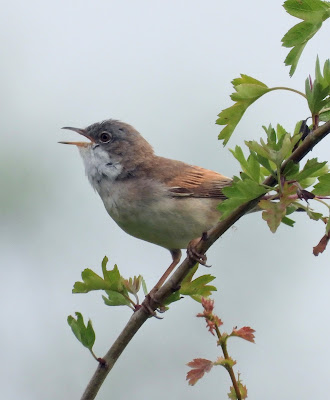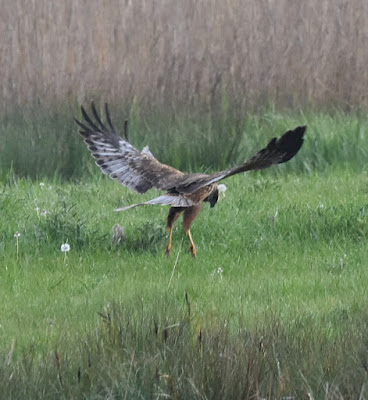 |
| Common Crane (c) JR |
Spring has rather passed me by this year in terms of keeping a regularly updated blog. This is by way of a catch-up and some rather random jottings and pictures.
 |
| Bittern (c) Bark |
 |
| Common Tern (c) Bark |
It has at times been very windy but that seems not to have had many adverse effects on the spring migration.

Crane family (c) Bark
The Ashgrave
Cranes have been the great story this Spring. It has been very exciting to have
a pair of Cranes with two chicks in tow walking about and feeding in the open
on Ashgrave in front of the hide. Sometimes they are huge distances away but
can come quite close, much to the delight of visitors. As I write this the
chicks are almost nine weeks out of the egg and are looking strong and healthy
as they lose their ginger down and start to fledge up properly.
 |
| Cranes (c) JR |
It was possible to see the parent birds attentively feeding the chicks early on and now it is obvious that they are foraging for themselves and judging by their steady growth finding lots to eat. They still stay close to the parents and as the grass has got longer often disappear from view completely. In fact, the parents themselves often cannot be seen at all but their heads appearing just above the grass will eventually give away their location.
 |
| "Ted" and his partner (c) Bark |
There are another pair of Cranes present on the moor and they can often be seen feeding out on Noke Sides or flying over Greenaways and the fields beyond. Their breeding attempt sadly failed this year. They can often be heard bugling as they fly, and the male “Ted” is easy to identify as he is much larger than his companion. Although the birds spend the entire winter in large flocks on the Somerset Levels, they are very territorial when breeding and very vocal should one pair venture into the range of another.

Newly fledged Reed Bunting (c) Bark
There have
been frequent visits from all three Egret species with Little Egrets being the
most frequently seen. Little Egrets tend not to be around so much in the spring
and early summer, and we have speculated that they may be breeding nearby.
Cattle Egrets are breeding at Blenheim and just as last year we expect that
they will be seen more frequently as the summer wears on out on the fields
around the grazing livestock.
 |
| Carpark Garden Warbler (c) Bark |
All the warblers arrived on cue and there were probably three or four reeling Grasshopper Warblers across the moor.
 |
| Cetti's above (c) JR and Common Whitethroat below (c) Darrell Woods |
There is a very persistent and showy Garden warbler in the car park field. It has a very complex and beautiful song and hearing it one can appreciate why they are sometimes referred to as “ a poor man’s nightingale”.
 |
| Showy Sedgie (c) Bark |
Every year we seem to have one extremely confiding and dynamic Sedge Warbler somewhere along the bridleway. This year has been no different and a male Sedgie has entertained us all and become the subject of hundreds of photographs. The energy expended by the bird, in its furious and demented song culminating in a parachute descent, is enormous. It has looked stunning, especially when singing among the dog roses.
 |
| Gropper Reeling (c) Bark |
Cuckoos on Otmoor seem to be bucking the national downward trend. Last weekend (12th June) we saw at least six birds together chasing and calling, flying between the oak trees on the bridleway, the permissive path and the trees behind the first screen.
 |
| Top picture (c) Tom NL others (c) Bark |
It may be our healthy population of Reed Warblers that attract them and sustain their population.
 |
| Reed warbler (c) Bark |
For the third year running we have singing Corn Buntings on the moor and are hopeful that they will breed again successfully this year.
 |
| Corn Buntings (c) Bark |
Female Bitterns are undertaking feeding flights and can often be seen across Greenaways, the males take no active part in raising the young.
 |
| Bittern coming in with food (c) Bark |
There have been some more unusual sightings this spring including a Spoonbill that spent a number of days on and around the moor. It often seemed to disappear as it fed along the ditches with its head down.
 |
| Spoonbill (c) Dan and Trish Miller |
An Osprey flew over the reserve just last week but did not tarry. A Tawny Owl was seen and photographed in a tree close to the hide.

Male Marsh Harrier hunting over Greenaway's (c) Bark
Marsh
Harriers have been ever present and on Sunday the first of this year’s progeny
was seen perched on top of a bush eating a prey item supplied by one of the
parents. There was a strong passage of Hobbies earlier in May with over twenty
being seen across Greenaway’s on one evening. There are still several about that
can be seen hunting dragonflies, usually from mid-morning onwards.
Songthrush by the first screen (c) Bark
Snipe are
still drumming and there seem to more pairs present this year, they are
displaying over Greenaways and Closes. 
Curlew (c) Bark
There are still active Curlew nests
across the moor, the practice of putting low electric fences around them once
they have been found deters mammalian predators from taking the eggs. There is
however a flock of Curlew present that is probably composed of birds that have been
unsuccessful in breeding this year. We were treated to a very close encounter
with a pair of Redshanks that were moving their clutch of five chicks from
Greenaways across the bridle way to Closes.
 |
| Adult and chick Redshanks (c) Bark |
The birds called and flew close and low over our heads in a distraction display while five chicks with absurdly large feet tottered across the path and disappeared again into the long grass.
 |
| Male Bullfinch collecting food (c) Bark |
The moor is at its most lush and verdant right now, with dog-roses, brambles and a host of other weeds bursting into flower, and grasses are setting seed. Birds are gathering food to supply hungry nestlings as the insect population swells.
 |
| Common Lizard (c) Bark |
Lizards can be seen basking outside the first screen and there are loopy leverets running down the paths oblivious of to our presence until the very last moment.
 |
| Loopy Leveret (c) Bark |
It is a wonderful time of year to be out and about on Otmoor.
 |
| Dog Rose (c) Bark |















